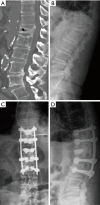Kyphoplasty versus percutaneous posterior instrumentation for osteoporotic vertebral fractures with posterior wall injury: a propensity score matched cohort study
- PMID: 33834130
- PMCID: PMC8024763
- DOI: 10.21037/jss-20-625
Kyphoplasty versus percutaneous posterior instrumentation for osteoporotic vertebral fractures with posterior wall injury: a propensity score matched cohort study
Abstract
Background: Osteoporotic vertebral fractures (OVFs) that present with posterior wall cortical injury pose a higher risk for instability. Surgical management includes standard cement augmentation techniques like balloon kyphoplasty (BKP) or percutaneous posterior instrumentation with pedicle screws (PS) or both. Neither treatment has yet demonstrated superiority, and posterior cement leakage is of special concern in these fractures.
Methods: At a single tertiary care center, 25 patients with 32 OVFs with posterior wall injury treated with percutaneous instrumentation and cement augmentation (PS group) were retrospectively included and matched (1:1) using propensity scores to 25 patients with 29 OVFs with posterior wall injury treated with standalone BKP (BKP group) from 2010 to 2018. Our primary study aim identified 30-day morbidity rates using a 4-point grading system by comparing BKP with and without percutaneous instrumentation with PS for the treatment of OVFs with posterior wall injury. Our secondary aims evaluated cement leakage, radiographic results, surgical time, length of stay (LOS), pain relief, and subsequent fractures.
Results: Overall 30-day morbidity was 34% and did not differ between groups (24% BKP vs. 44% PS groups, P=0.136). Most complications were mild (82.4%), requiring no interventions beyond drug treatment. In the PS group, a trend towards more mild complications was observed (16% vs. 40%, P=0.059). Moderate and severe complications affected 17.6% of all morbidity cases and were comparable between groups. Asymptomatic cement leakage into the spinal canal was noted in 2 (8%) BKP patients and symptomatic pulmonary cement embolism in 1 (4.8%) PS patient. Compared with baseline, all radiographic parameters significantly improved in both groups. In the BKP group, mean surgical times (52±32.9 vs. 164.9±48.4 minutes, P<0.001) and LOS (4.3±2.5 vs. 7±2.9 days, P<0.001) were significantly shorter, and use of opioids at discharge was significantly lower (52% vs. 84%, P=0.015). At 3-month follow-up, no differences between groups were seen in back pain, use of opioids, and occurrence of subsequent OVFs. Follow-up averaged 8.4 months.
Conclusions: Standalone BKP may be a viable option for the treatment of OVFs even in the presence of posterior wall cortical injury.
Keywords: Osteoporosis; cement augmentation; kyphoplasty; posterior wall injury; vertebral fracture.
2021 Journal of Spine Surgery. All rights reserved.
Conflict of interest statement
Conflicts of Interest: All authors have completed the ICMJE uniform disclosure form (available at http://dx.doi.org/10.21037/jss-20-625). MM and EN report an institutional research grant from Medtronic during the conduct of the study. The other author has nothing to disclose.
Figures





References
LinkOut - more resources
Full Text Sources
Other Literature Sources
